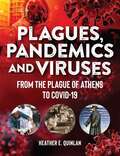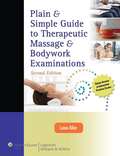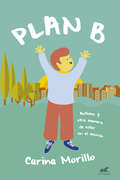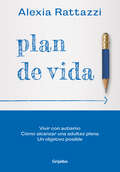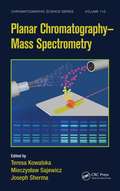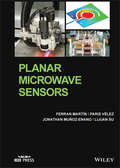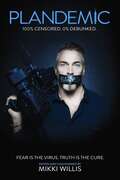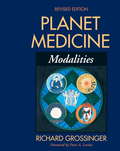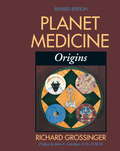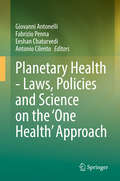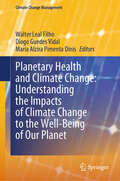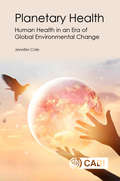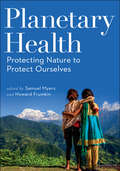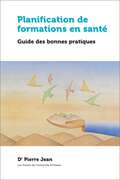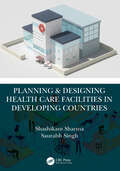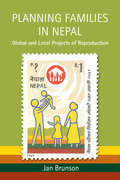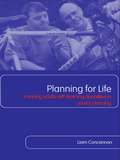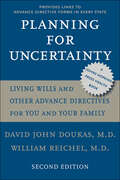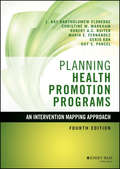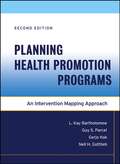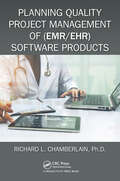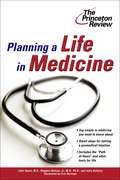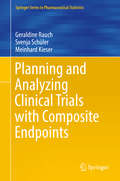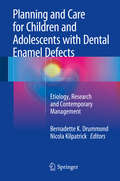- Table View
- List View
Plagues, Pandemics And Viruses: From The Plague Of Athens To Covid 19
by Heather E. QuinlanPandemics can come in waves―like tidal waves. They change societies. They disrupt life. They end lives. As far back as 3000 B.C.E. (the Bronze Age), plagues have stricken mankind. COVID-19 is just the latest example, but history shows that life continues. It shows that knowledge and social cooperation can save lives. Viruses are neither alive nor dead and are the closest thing we have to zombies. Their only known function is to replicate themselves, which can have devastating consequences on their hosts. Most, but not all, bacteria are good for us. Some are truly horrific, including those that caused the bubonic, pneumonic, and septicemic plagues. And viruses and bacteria are always morphing, evolving, and changing, making them hard to treat. Plagues, Pandemics, and Viruses: From the Plague of Athens to Covid 19 is an enlightening, and sometimes frightening, recounting of the destruction wrought by disease, but it also looks at what man has done and can do to overcome even the deadliest and bleakest of contagions. More than two years in the making, author Heather E. Quinlan was deep into her research and writing when COVID hit. She quickly saw the similarities to plagues from the past. Plagues, Pandemics, and Viruses: From the Plague of Athens to Covid 19 not only covers the history, causes, medical treatments, human responses, and aftermath of the world’s biggest pandemics, but it also draws parallels to the present. It chronicles the diseases that have inflicted man throughout the millennia, including … The differences (and similarities) between COVID-19 and other coronaviruses The bubonic plague/black plague, which wiped out 30% to 60% of Europe’s population The devastation to the indigenous population during the European colonization of the Americas The 1918 Spanish Flu, which did not come from Spain How disease “inspired” The Canterbury Tales, Wuthering Heights, the pop art of Keith Haring, and other art and literature AIDS’ “patient zero” How climate change will affect future pandemics The aftermath of various pandemics Several modern diseases making a comeback … and much, much more. Along with investigating some of history’s most notorious pandemics and diseases, Plagues, Pandemics, and Viruses takes a look at human resilience and what we’ve learned from the past. It looks at how science, the medical community, and governments have conquered or mitigated most epidemics even before they can turn into pandemics. It reviews the science of pandemics, preventative measures, and medical interventions and it includes an exclusive interview with Dr. Anthony S. Fauci, director of the National Institute of Allergy and Infectious Diseases, as well as other experts in the medical community. Richly illustrated, it also has a helpful bibliography and extensive index. This invaluable resource is designed to help you understand, and protect you from, plagues, pandemics, epidemics, viruses, and disease!
Plain and Simple Guide to Therapeutic Massage and Bodywork Examinations (2nd edition)
by Laura AllenThis comprehensive review guide for therapeutic massage and bodywork certification is written in plain, simple language to put the test-taker at ease. The book is organized according to the National Certification Examination, and each chapter is presented as an outline review, with end-of-chapter review questions. Positive affirmations and quotations help calm the reader's test-taking anxiety. This Second Edition provides coverage of the Massage & Bodywork Licensing Exam (MBLEx) and includes at least five additional review questions per chapter. A companion Website offers student and instructor resources such as practice exams, interactive flash cards, game show questions, Millionaire game questions, labeling activities, a quiz bank, a test generator, a syllabus, lesson plans, and PowerPoint slides.
Plan B: Autismo y otra manera de estar en el mundo
by Carina MorilloEn Plan B, Carina Morillo no solo nos ofrece un testimonio sincero del viaje personal luego de que su hijo fuera diagnosticado con autismo, sino también una guía práctica y esperanzadora para quienes quieran desarrollar la resiliencia y así enfrentar los desafíos que la vida nos presenta. En 2002, Carina Morillo vivía en Luxemburgo junto a su familia. Al cumplir su hijo menor, Iván, los dos años y medio fue diagnosticado con autismo, y entonces decidieron volver a la Argentina. Ese regreso se convirtió para ella en un camino de transformación. Fue darse cuenta de que su currículum de logros no le servía para nada frente a las dificultades que su hijo tenía que enfrentar, y que su única certeza era que quería la felicidad de Iván. Que su familia fuese feliz. Ser feliz ella misma. Por nada del mundo se iba a apartar de ese objetivo. Descarnado e inspirador, Plan B trata sobre el poder del amor y el coraje frente a los obstáculos y las oportunidades que pueden surgir cuando nos despejamos de nuestros prejuicios y aprendemos a aprovechar nuestro verdadero potencial. Una invitación a mirar la realidad como un lugar de eternas posibilidades.
Plan de vida: Vivir con autismo. Cómo alcanzar una adultez plena. Un objetivo posible
by Alexia RattazziEn este nuevo libro Alexia Rattazzi, doctora especialista en autismo, propone ideas, experiencias y herramientas para acompañar a personas adultas con autismo a llevar una vida social plena, libre y autónoma. Me encantaría vivir en un mundo en el que cada persona sea quien es y pueda ejercer sus derechos plenamente, en igualdad de condiciones que las demás. Todos tenemos derecho a elegir qué hacer de nuestras vidas. Pero ¿cómo garantizarles hoy, en esta sociedad, ese ejercicio pleno de derechos a las personas con autismo? Lo primero es visibilizar esta condición. Identificar y derribar barreras, brindar apoyos y pensar caminos posibles. En este, su nuevo libro, Alexia Rattazzi, especialista en autismo, aborda problemas como el del acceso a la salud, a la educación superior, al empleo con apoyos en el mercado laboral abierto y competitivo, a la independencia y a la autodeterminación. A vivir donde y con quien se quiera, a la sexualidad y las relaciones afectivas, a la justicia, al turismo, al deporte, al ocio, a la recreación, a la comunicación y al bienestar. En definitiva, a todas esas cosas que nos permiten disfrutar de nuestro paso por el mundo, a solas o en compañía. Plan de vida es una invitación a construir una convivencia humana neurodiversa y pacífica y a seguir creando contextos amigables y amables para todos.
Planar Chromatography - Mass Spectrometry (Chromatographic Science Series)
by Teresa Kowalska Mleczyslaw Sajewlcz Joseph SharmaPlanar Chromatography-Mass Spectrometry focuses on a relatively new approach to chemical analysis in general, and to separation science in particular. It is the first book to systemically cover the theoretical background, techniques, instrumentation, and practical applications of planar chromatography-mass spectrometry as a hyphenated tool of analy
Planar Microwave Sensors (IEEE Press)
by Ferran Martín Paris Vélez Jonathan Muñoz-Enano Lijuan SuComprehensive resource detailing the latest advances in microwave and wireless sensors implemented in planar technology Planar Microwave Sensors is an authoritative resource on the subject, discussing the main relevant sensing strategies, working principles, and applications on the basis of the authors’ own experience and background, while also highlighting the most relevant contributions to the topic reported by international research groups. The authors provide an overview of planar microwave sensors grouped by chapters according to their working principle. In each chapter, the working principle is explained in detail and the specific sensor design strategies are discussed, including validation examples at both simulation and experimental level. The most suited applications in each case are also reported. The necessary theory and analysis for sensor design are further provided, with special emphasis on performance improvement (i.e., sensitivity and resolution optimization, dynamic range, etc.). Lastly, the work covers a number of applications, from material characterization to biosensing, including motion control sensors, microfluidic sensors, industrial sensors, and more. Sample topics covered in the work include: Non-resonant and resonant sensors, reflective-mode and transmission-mode sensors, single-ended and differential sensors, and contact and contactless sensors Design guidelines for sensor performance optimization and analytical methods to retrieve the variables of interest from the measured sensor responses Radiofrequency identification (RFID) sensor types, prospective applications, and materials/technologies towards “green sensors” implementation Comparisons between different technologies for sensing and the advantages and limitations of microwave sensors, particularly planar sensors Engineers and qualified professionals involved in sensor technologies, along with undergraduate and graduate students in related programs of study, can harness the valuable information inside Planar Microwave Sensors to gain complete foundational knowledge on the subject and stay up to date on the latest research and developments in the field.
Plandemic: Fear Is the Virus. Truth Is the Cure.
by Mikki WillisThe incredible true story of the most banned documentary in history. Researching the controversy arising after the release of the viral phenomenon known as Plandemic, the most seen and censored documentary in history, an investigative journalist sets out to disprove and debunk claims made throughout the film. Instead, the journalist opens a Pandora&’s box to witness firsthand an underworld of corruption, lies, and the darkest of unsolved mysteries. The result? A fascinating behind-the-scenes account about the making of Plandemic and Plandemic: Indoctornation; an exposé of the truth behind the origins of COVID-19; an alarming examination of individuals, such as Dr. Anthony Fauci and Bill Gates, and organizations like the CDC, NIH, WHO, and Bill & Melinda Gates Foundation, among others, driving the global vaccination agenda; and a look at the tech giant and mainstream media forces doing their utmost to silence and suppress the veracity of these findings. Investigative filmmaker Mikki Willis focuses his unflinching lens on two key subjects: virologist Dr. Judy Mikovits, who speaks frankly about the machinations for control and profit corrupting individuals and institutions tasked with overseeing public health; and Dr. David E. Martin, whose research and shocking data corroborate allegations of conflicts of interest. The US media and fact checkers condemned the two documentaries as &“dangerous conspiracy theory.&” Today, the two-part bombshell is being hailed globally for warning the world of the crimes against humanity that are just now being uncovered. From the death of his brother and mother due to bad medicine, to his awakening at Ground Zero on 9/11, Mikki Willis describes in detail the incredible life experiences that led him to risk his career and safety to create the Plandemic series.
Planet Medicine: Modalities, Revised Edition
by Peter A. Levine Richard GrossingerPlanet Medicine is a major work by an anthropologist who looks at medicine in a broad context. In this edition, additions to this classic text include a section on Reiki, a comparison of types of palpation used in healing, updates on craniosacral therapy, and a means of understanding how different alternative medicines actually work. Illustrated throughout, this is the standard on the history, philosophy, and anthropology of this subject.
Planet Medicine: Origins, Revised Edition
by John E. Upledger Richard GrossingerPlanet Medicine is a major work by an anthropologist who looks at medicine in a broad context. In this edition, additions to this classic text include a section on Reiki, a comparison of types of palpation used in healing, updates on craniosacral therapy, and a means of understanding how different alternative medicines actually work. Illustrated throughout, this is the standard on the history, philosophy, and anthropology of this subject.
Planetary Health - Laws, Policies and Science on the 'One Health' Approach
by Giovanni Antonelli Fabrizio Penna Eeshan Chaturvedi Antonio CilentoThis book offers a multidisciplinary and in-depth analysis of the One Health approach. The holistic One Health vision, a healthcare model based on the integration of various disciplines, is both ancient and current. It is based on the recognition that human health, animal health and ecosystem health are inextricably linked. Cognizant of the need for multidisciplinary research to address complex health challenges at the national and international level, the book combines legal, public policy and medical perspectives on the One Health approach, exploring e.g. the role of biodiversity, human rights, trade agreements, indigenous knowledge, and climate change mitigation and adaptation. One Health is officially recognized by the European Commission and by a host of international organizations as a relevant strategy for actors in all sectors that benefit from collaboration between disciplines (doctors, veterinarians, lawyers, environmentalists, economists, sociologists etc.). One Health is an ideal approach to achieving global health, as it addresses the needs of the most vulnerable populations based on the intimate relationship between their own health, that of their animals, and that of the environment in which they live, considering the wide spectrum of determinants that emerge from this relationship. Given its scope, the book will be of interest to academics, professionals, and students of all disciplines who engage with the One Health approach.
Planetary Health and Climate Change: Understanding the Impacts of Climate Change to the Well-Being of Our Planet (Climate Change Management)
by Walter Leal Filho Diogo Guedes Vidal Maria Alzira Pimenta DinisThis book aims to provide a comprehensive overview of how climate change affects planetary health and what this means for our collective future. In recent years, the discourse surrounding climate change has grown increasingly urgent and for good reasons. Our planet is undergoing unprecedented transformations driven by human activities, which are altering the delicate balance of our ecosystems. The term "planetary health" has emerged to encapsulate the interdependent relationship between the health of human populations and the health of the natural systems on which we depend. The genesis of this book lies in a simple yet profound realization: the well-being of our planet is inextricably linked to our own well-being. The air we breathe, the water we drink, the food we consume—all are products of a complex web of environmental processes that are now being disrupted by climate change. As temperatures rise, sea levels increase, and weather patterns become more erratic, the ripple effects touch every aspect of life on Earth, from human health to biodiversity, from food security to economic stability. The chapters within this book are contributions from leading experts across various fields—climate science, ecology, medicine, economics, and social sciences—each providing unique insights into the multifaceted impacts of climate change. We explore the scientific evidence of climate change and discuss the consequences for natural and human systems and potential solutions that can help mitigate these impacts. This interdisciplinary approach is needed, as the challenges posed by climate change are complex and interconnected, requiring holistic and collaborative strategies. This book does not merely catalog the problems; it also focuses on solutions. From innovative technologies to policy frameworks and grassroots movements, there are numerous pathways to a more sustainable and equitable future. The transition to a low-carbon economy, the restoration of degraded ecosystems, and the implementation of effective public health strategies are just a few of the measures that can help us navigate the challenges ahead. With its engaging narrative, richly detailed analysis, and forward-looking perspective, the book is an essential read for anyone concerned about the fate of our planet and the critical role of climate change in influencing it. It serves as a clarion call to action, urging readers to consider the legacy we wish to leave for future generations.
Planetary Health: Human Health in an Era of Global Environmental Change
by Jennifer ColePlanetary Health - the idea that human health and the health of the environment are inextricably linked - encourages the preservation and sustainability of natural systems for the benefit of human health. Drawing from disciplines such as public health, environmental science, evolutionary anthropology, welfare economics, geography, policy and organizational theory, it addresses the challenges of the modern world, where human health and well-being is threatened by increasing pollution and climate change. A comprehensive publication covering key concepts in this emerging field, Planetary Health reviews ideas and approaches to the subject such as natural capital, ecological resilience, evolutionary biology, One Earth and transhumanism. It also sets out through case study chapters the main links between human health and environmental change, covering: - Climate change, land use and waterborne infectious diseases. - Sanitation, clean energy and fertilizer use. - Trees, well-being and urban greening. - Livestock, antibiotics and greenhouse gas emissions. Providing an extensive overview of key theories and literature for academics and practitioners who are new to the field, this engaging and informative read also offers an important resource for students of a diverse range of subjects, including environmental sciences, animal sciences, geography and health.
Planetary Health: Protecting Nature to Protect Ourselves
by Howard Frumkin Samuel MyersHuman health depends on the health of the planet. Earth's natural systems—the air, the water, the biodiversity, the climate—are our life support systems. Yet climate change, biodiversity loss, scarcity of land and freshwater, pollution and other threats are degrading these systems. The emerging field of planetary health aims to understand how these changes threaten our health and how to protect ourselves and the rest of the biosphere.Planetary Health: Protecting Nature to Protect Ourselves provides a readable introduction to this new paradigm. With an interdisciplinary approach, the book addresses a wide range of health impacts felt in the Anthropocene, including food and nutrition, infectious disease, non-communicable disease, dislocation and conflict, and mental health. It also presents strategies to combat environmental changes and its ill-effects, such as controlling toxic exposures, investing in clean energy, improving urban design, and more. Chapters are authored by widely recognized experts.The result is a comprehensive and optimistic overview of a growing field that is being adopted by researchers and universities around the world. Students of public health will gain a solid grounding in the new challenges their profession must confront, while those in the environmental sciences, agriculture, the design professions, and other fields will become familiar with the human consequences of planetary changes. Understanding how our changing environment affects our health is increasingly critical to a variety of disciplines and professions. Planetary Health is the definitive guide to this vital field.
Planification de formations en santé: Guide des bonnes pratiques (Éducation)
by Pierre JeanConcevoir une activité de formation peut être intimidant ; réformer tout un programme d’études l’est d’autant plus. Voici un guide pratique de planification des apprentissages à l’intention des formateurs qui n’ont pas nécessairement une longue expérience dans le domaine. Principalement conçu pour les enseignants et les responsables de la formation des professionnels de la santé, ainsi que les professeurs universitaires, cet ouvrage propose une démarche qui peut servir à la planification de tout un programme d’études, une formation continue ou un stage. L’approche expérientielle est privilégiée et cinq études de cas en ont émergé, émanant du Canada et de pays émergents. Le langage est simple, évitant le jargon des experts en pédagogie. De plus, une série de tableaux récapitulatifs permet de s’y retrouver rapidement. Fondé sur les théories du changement et sur les principes de la planification systématique des apprentissages, ce guide, qui se veut pratique, est issu du monde médical mais est tout à fait pertinent pour les autres sciences de la santé et les autres disciplines professionnelles.Publié en français
Planning & Designing Health Care Facilities in Developing Countries
by Saurabh Singh Shashikant SharmaBuilding a clinically integrated workplace with a high level of clinical competence requires careful considerations of Hospital Planning. For greenfield or brownfield hospital projects, clinicians and C-Suite executives need to acquire capabilities to address the planning needs of any organization. This book aims to provide both theoretical and practical inputs for the Planning & Designing of Health Care Facilities in Developing Countries. It clearly indicates the steps to be followed, facts to be weighed, and components to be considered to arrive at a correct planning solution. With health reform looming and the revenue base shifting rapidly, we need to integrate patient safety concerns in the design process. Key Features• Liberal use of tables and figures to support conclusions, illustrate concepts, and display quantitative information, making it easier for readers to understand and refer to large quantities of data• Integrates the international norms for planning and designing health care facilities into the developing country setting• Handbook and ready reckoner for C-Suite executives, hospital engineers, project consultants, and hospital administration students
Planning Clinical Research
by Robert A. Parker Berman Nancy GreenePlanning a clinical study is much more than determining the basic study design. Who will you be studying? How do you plan to recruit your study subjects? How do you plan to retain them in the study? What data do you plan to collect? How will you obtain this data? How will you minimize bias? All these decisions must be consistent with the ethical considerations of studying people. This book teaches how to choose the best design for your question. Drawing on their many years working in clinical research, Nancy G. Berman and Robert A. Parker guide readers through the essential elements of study planning to help get them started. The authors offer numerous examples to illustrate the key decisions needed, describing what works and what does not work, and why. Written specifically for junior investigators beginning their research careers, this guide will also be useful to senior investigators needing to review specific topics.
Planning Families in Nepal: Global and Local Projects of Reproduction
by Jan BrunsonBased on almost a decade of research in the Kathmandu Valley, Planning Families in Nepal offers a compelling account of Hindu Nepali women as they face conflicting global and local ideals regarding family planning. Promoting a two-child norm, global family planning programs have disseminated the slogan, "A small family is a happy family," throughout the global South. Jan Brunson examines how two generations of Hindu Nepali women negotiate this global message of a two-child family and a more local need to produce a son. Brunson explains that while women did not prefer sons to daughters, they recognized that in the dominant patrilocal family system, their daughters would eventually marry and be lost to other households. As a result, despite recent increases in educational and career opportunities for daughters, mothers still hoped for a son who would bring a daughter-in-law into the family and care for his aging parents. Mothers worried about whether their modern, rebellious sons would fulfill their filial duties, but ultimately those sons demonstrated an enduring commitment to living with their aging parents. In the context of rapid social change related to national politics as well as globalization--a constant influx of new music, clothes, gadgets, and even governments--the sons viewed the multigenerational family as a refuge. Throughout Planning Families in Nepal, Brunson raises important questions about the notion of "planning" when applied to family formation, arguing that reproduction is better understood as a set of local and global ideals that involve actors with desires and actions with constraints, wrought with delays, stalling, and improvisation.
Planning For Life: Involving Adults with Learning Disabilities in Service Planning
by Liam ConcannonThis book traces the development of services for people with disabilities and discusses how much things have really changed for today's 'service users' since the days of asylums. It also assesses whether the policy of involvement, such as that outlined in Valuing People, is achievable in practice or simply places unrealistic burdens on professionals and service users.Based on findings from original research and interviews, the author argues that involving people with learning disabilities in service planning is difficult to achieve successfully and is currently, to a large extent, tokenistic. This area of challenging practice and emotive debate is brought to life by the voices of service providers, carers and the service users themselves, and illustrates the realities of working with people with learning disabilities.Planning for Life is valuable and informative for students of social work, social care and social policy, and will be enlightening reading for those working with adults with learning disabilities, in policy and in practice.
Planning For Uncertainty: Living Wills and Other Advance Directives for You and Your Family (A Johns Hopkins Press Health Book)
by William Reichel David John DoukasA practical guide to documenting your decisions and preferences in case of incapacitating illness.It won’t happen to me.I’m too busy to worry about a living will.My family will know what to do.No one wants to plan for incapacitating illness or death. But to spare loved ones from needless emotional suffering, or even legal battles, people of all ages need to document and communicate clear decisions about the final details of their lives while they are healthy and have time to fully consider their own values and preferences.Here, Drs. David Doukas and William Reichel help individuals make decisions and communicate their wishes to health care providers and family members and other loved ones. They use a question-and-answer format to guide readers through the process—emphasizing the crucial connection between values and treatment preferences. They explain advance directives and the health care decision-making process, including the values history, family covenants, proxies, and proxy negation. The appendix includes resources and web links for learning about advance directive requirements and obtaining legal forms in all fifty states.This practical guide helps people navigate the intimidating but important process of thinking about, and planning for, an uncertain future.
Planning Health Promotion Programs
by Guy S. Parcel Gerjo Kok Maria E. Fernández Robert A. Ruiter L. Kay Bartholomew Eldredge Christine M. MarkhamThe Intervention Mapping bible, updated with new theory, trends, and cases Planning Health Promotion Programs is the "bible" of the field, guiding students and practitioners through the planning process from a highly practical perspective. Using an original framework called Intervention Mapping, this book presents a series of steps, tasks, and processes that help you develop effective health promotion and education programs using a variety of approaches. As no single model can accurately predict all health behavior or environmental changes, this book shows you how to choose useful theories and integrate constructs from multiple theories to describe health problems and develop appropriate promotion and education solutions. This new fourth edition has been streamlined for efficiency, with information on the latest theories and trends in public health, including competency-based training and inter-professional education. New examples and case studies show you these concepts in action, and the companion website provides lecture slides, additional case studies, and a test bank to bring this book directly into the classroom. Health education and health promotion is a central function of many public health roles, and new models, theories, and planning approaches are always emerging. This book guides you through the planning process using the latest developments in the field, and a practical approach that serves across discipline boundaries. Merge multiple theories into a single health education solution Learn the methods and processes of intervention planning Gain a practical understanding of multiple planning approaches Get up to date on the latest theories, trends, and developments in the field Both academic and practice settings need a realistic planning handbook based on system, not prescription. Planning Health Promotion Programs is the essential guide to the process, equipping you with the knowledge and skills to develop solutions without a one-size-fits-all approach.
Planning Health Promotion Programs
by L. Kay Bartholomew Guy S. Parcel Gerjo Kok Nell H. GottliebThis thoroughly revised and updated third edition of Planning Health Promotion Programs provides a powerful, practical resource for the planning and development of health education and health promotion programs. At the heart of the book is a streamlined presentation of Intervention Mapping, a useful tool for the planning and development of effective programs. The steps and tasks of Intervention Mapping offer a framework for making and documenting decisions for influencing change in behavior and environmental conditions to promote health and to prevent or improve a health problem. Planning Health Promotion Programs gives health education and promotion professionals and researchers information on the latest advances in the field, updated examples and explanations, and new illustrative case studies. In addition, the book has been redesigned to be more teachable, practical, and practitioner-friendly.
Planning Quality Project Management of (HIMSS Book Series)
by Richard ChamberlainWhen hospitals began implementing their electronic medical records/electronic health records systems (EMR/HER) the pharmaceutical companies that were conducting clinical trials at those hospitals wanted to sue the date from those systems instead of having the hospitals enter the data in their EHR systems and also in the study data entry system. However, the FDA regulations would require that the hospital systems be "validated". The hospitals and the companies developing the systems argued that was "over-regulation." HIMSS published their Developer Code of Conduct where they said instead they would use Quality Management techniques. This book covers how to use Quality Management (ISO 9001) to develop computer systems, specifically EMR systems. It gives a basic introduction to how to implement computer systems. It also covers the topic of compliance because the hospitals are required to comply with regulations other than FDS regulations. The book also discusses the topics of risk management and conducting audits, both of which are part of ISO 9001 quality management of computer systems. The book is designed to give the reader an introduction to the things you have to do when implementing a computer system that has to satisfy some standards and where the accuracy of the information could impact the accuracy of a person’s medical treatment.
Planning a Life in Medicine: Discover If a Medical Career Is Right for You and Learn How to Make It Happen (Career Guides)
by Princeton Review John Smart Stephen Nelson Julie DohertyA life in medicine is something that many dream of but few achieve. The tests students face-both literal and figurative-just to get into medical school are designed to weed out the weak. In Planning a Life in Medicine, the experts at The Princeton Review help you succeed in a premedical program, score higher on the MCAT, meet the challenges of medical school, and ultimately flourish in your medical career. More than just a comprehensive plan for getting into medical school, Planning a Life in Medicine is a handbook that will help you to cultivate the skills and habits-such as compartmentalizing knowledge and improving concentration-that will help you along your "path of heart" and serve you well throughout your education and medical career.
Planning and Analyzing Clinical Trials with Composite Endpoints (Springer Series In Pharmaceutical Statistics Ser.)
by Geraldine Rauch Meinhard Kieser Svenja SchülerThis book addresses the most important aspects of how to plan and evaluate clinical trials with a composite primary endpoint to guarantee a clinically meaningful and valid interpretation of the results. Composite endpoints are often used as primary efficacy variables for clinical trials, particularly in the fields of oncology and cardiology. These endpoints combine several variables of interest within a single composite measure, and as a result, all variables that are of major clinical relevance can be considered in the primary analysis without the need to adjust for multiplicity. Moreover, composite endpoints are intended to increase the size of the expected effects thus making clinical trials more powerful. The book offers practical advice for statisticians and medical experts involved in the planning and analysis of clinical trials. For readers who are mainly interested in the application of the methods, all the approaches are illustrated with real-world clinical trial examples, and the software codes required for fast and easy implementation are provided. The book also discusses all the methods in the context of relevant guidelines related to the topic. To benefit most from the book, readers should be familiar with the principles of clinical trials and basic statistical methods.
Planning and Care for Children and Adolescents with Dental Enamel Defects
by Bernadette K. Drummond Nicola KilpatrickDefective development of tooth enamel or dentin is a significant dental problem for children and adolescents in various respects, and dentists and other oral health workers find managing these problems challenging and stressful. While a considerable amount of relevant research is currently being undertaken, much further investigation is needed. This book discusses the known causes of defective dental enamel and explains why it is so difficult to restore. Most importantly, it presents the signs and symptoms that allow accurate diagnosis and documents the best contemporary management. The full range of enamel defects is considered, including defects in primary teeth and permanent teeth, associated syndromes, molar incisor hypomineralization, and genetic defects. The clinical chapters are well illustrated, providing clear guidelines for each procedure. In addition, avenues for future research are identified, with explanation of their rationale.
